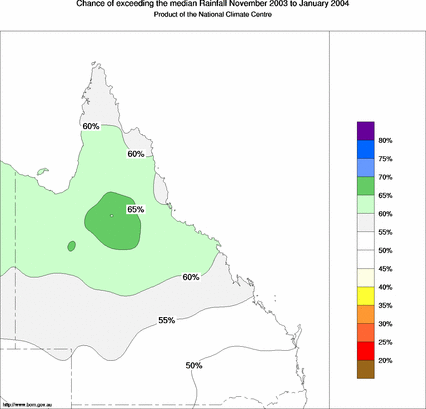Above average falls likely in north Queensland
The Bureau's rainfall outlook for the late spring to mid-summer
period shows that above average seasonal falls are favoured across the
northern half of Queensland.
This outlook is largely the result of temperature patterns in the
Indian Ocean.
For the November to January period, the chances of above median
rainfall are between 60 and 70% north of about Mackay, but excluding
the far north of Cape York and parts of the wet tropics (see map).
So with climate patterns like the current,
about 6 or 7 seasons out of 10 are expected to be wetter than average in
this part of the State, with about 3 or 4 out of 10 being drier.

In southern Queensland, the odds for above average seasonal falls
are close to 50:50.
Outlook confidence is related to the influence of Pacific and Indian
Ocean temperatures on seasonal rainfall. During November to January,
history shows this influence to be moderate across much of
Queensland, and mainly weak in the west (see background information).
The tropical Indian Ocean is currently somewhat warmer than average,
but has been cooling quite strongly. The Pacific is generally
warmer than average, particularly in the west. For more detail
see the El Niño Wrap-Up.
The recent temperature changes in the Indian Ocean are the dominant
influence on the overall pattern of probabilities.
September's value of the Southern Oscillation Index
(SOI) was –2, the same as that recorded in August.
The approximate SOI for the 30 days ending 13th October was –1.
|